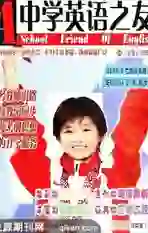新目标七年级(下)Units7—8词语辨析
2008-05-13赵贤
赵 贤
Unit 7
1.a bit; a little
a bit和a little在肯定句中修饰动词、形容词、副词及其比较级时,可以互换。表示“一点儿”的意思。例如:
The speaker spoke up a bit/a little louder so as to make himself heard more clearly.
讲演者把嗓门提高了一点,以便使别人听得更清楚一些。
In fact, the earth is actually a bit/a little nearer to the sun during the winter. 事实上,冬天地球离太阳更近一些。
a bit和a little在否定句中意思恰恰相反,not a bit相当于“not at all”(一点儿都不),not a little相当于“very(much)”。例如:
He wasnt a bit hungry.(=He wasnt hungry at all.) 他一点儿都不饿。
He wasnt a little hungry.(=He was very hungry.) 他饿极了。
注意:not a bit可分开使用,而not a little不可分开。
a little可直接作名词的定语,而a bit则要在后面加of构成短语才能作定语,二者都只能修饰不可数名词。例如:
Theres only a little(=a bit of) food left for lunch.
午餐只剩一点儿食物了。
说明:a bit of的复数形式是bits of, a little不能变复数。例如:
He took some paper and a few bits of wood and soon made a fire.
他取出一些报纸和一些木片很快生着了火。
There were bits of broken glass on the floor.
地板上有好几块玻璃碎片。
2. tall; high
tall常指长度、高度,往往含有高度或长度远过于宽度的细长形的东西的意味,常用来指人或动物。其反义词是short。high主要强调高于地面之上的垂直高度或借喻性的高。如:高山、高温、高速、高价等。其反义词是low。如:
a tall horse, a tall man, a tall tree, a high mountain, a high level, high clouds, high in price, high heels(高跟鞋)等。
指建筑物“高”既可用tall,也可用high。如:a tall/high building。
指人身材高矮用tall,也可用high。例如:
My brother is taller than me. 我弟弟比我个子高。
He is six feet high. 他身高六英尺。
指某人所处的空间位置高,只能用high,不能用tall。因为tall仅指从头到脚的一段长度,而high既可指从头到脚的长度,也可指离地面的一段距离。
3. person; people
person可以指man, woman或child,其复数形式是people。用person则强调数量的概念,比较正式。一个人应该说“a person”;不能说“a people”;两个人则可以说“two persons”或“two people”。例如:
There are only three persons in the room. 房间里只有三个人。
Among the people at the party, I did not know a single person.
聚会的人中,我一个也不认识。
people泛指人们;the people指人民或确指的人们;a people, peoples指民族,种族。例如:
Were there many people at the meeting? 出席会议的人多吗?
The Chinese are a hard-working people. 中华民族是勤劳的民族。
We should study hard for the people. 我们应该为人民而努力学习。
4. as; like
“像,如同”。like用于说明类似关系,即两者在形态上或性质上有相似之处,但并不等同。例如:
Dont treat me like a guest. 别把我当客人。
Like Lei Feng he has done a lot of good deals.
他像雷锋那样,做了许多好事。
as指“身份”或“资格”等,意为“作为,看作”等。例如:
Dont treat me as a child. 别把我当孩子看。
She has got a job as an editor. 她找到一份担任编辑的工作。
比较以下两句:
He works like a worker. 他像工人一样干活。(言外之意:He really isnot a worker.)
He works as a worker. 他作为一名工人而工作。(言外之意:He himself is a worker.)
like常见搭配有:look like, be like, like this, like that等。例如:
Dont treat him like that. 别那样对待他。
What does she look like? 她看起来怎样?
5. stop doing sth.; stop to do sth.
stop doing sth.意为“停止(正在)做的事情”。doing在句中是stop的宾语。例如:
When the teacher came in, the students stopped talking and laughing.
当老师走进来时,学生们停止了谈笑。
stop to do sth.意为“停下(正在做的事)去做某事”。to do sth.在句中是目的状语。例如:
He stopped to write a letter to her. 他停下手边的工作,给她写信。
Unit 8
6. as well as; also; too
三个词语都可表示“也”,但用法不同:
1)as well as 是并列连词,表示“也,还,同样”,用来连接同等成分即名词,代词,动词(用动词的ing形式),形容词,介词短语,不定式等。
注意:(A)连接两个主语时,谓语动词的数要与前面的主语保持一致。如:
She as well as you is a student. 她和你一样也是一个学生。
(B)连接不定式时,第一个不定式带to, 第二个不带to。如:
We want her to do the housework as well as look after the children.
我们要她既照顾孩子也干家务。
2)also是副词,表示“也, 还”,用在肯定句中。一般说来also是比较正式的用语,它经常放在句中,其位置在行为动词之前,be动词之后。如有助动词或情态动词,一般放在其后。如:
He also studies in that school. 他也在那个学校学习。
I can also tell you a story. 我也能给你讲个故事。
3)too副词,表示“也, 还”,用在肯定句中。一般放在句末,可用逗号隔开,也可不用。如置于句中,需前后用逗号分开。如:
He is in Class Two, too. 他也在二班。
She, too, is a singer. 她也是一位歌唱家。
7. big; great; large
三个都是形容词,表示“大”的意思。都可以在句中作定语和表语,只是程度和搭配上有差异。
1)big 使用得最广,反义词是small,可以指范围、重量、面积等方面,较口语化。如:
It is a big apple. 这是个大苹果。
There is a big tree in front of the house. 房前有一棵大树。
2)great常侧重于抽象化的东西,常带有主观的感情色彩。用来指人时表示“伟大的;杰出的”之意。如:
China is a great country. 中国是一个伟大的国家。
3)large 常用来指面积、体积、容积和数量,不常指人。如:
There is a large hall in our school. 我们学校有一个大厅。
